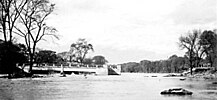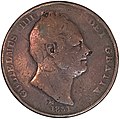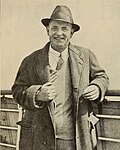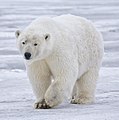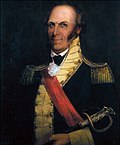Wikipedia:Today's featured article/October 2018
| << | Today's featured articles for October 2018 | >> | ||||
|---|---|---|---|---|---|---|
| Su | Mo | Tu | We | Th | Fr | Sa |
| 1 | 2 | 3 | 4 | 5 | 6 | |
| 7 | 8 | 9 | 10 | 11 | 12 | 13 |
| 14 | 15 | 16 | 17 | 18 | 19 | 20 |
| 21 | 22 | 23 | 24 | 25 | 26 | 27 |
| 28 | 29 | 30 | 31 | |||
October 1
Duncan Edwards (1 October 1936 – 21 February 1958) was an English footballer who played for Manchester United and the England national team. He played 151 matches as one of the Busby Babes, the young United team formed under manager Matt Busby in the mid-1950s. Born in Woodside, Dudley, Worcestershire, Edwards signed for Manchester United as a teenager and went on to become the youngest player to play in the Football League First Division. As the youngest England player since the Second World War, he played 18 times for his country at top level. In a professional career of less than five years he helped United win two Football League championships and two FA Charity Shields, and reached the semi-finals of the European Cup. He was one of eight United players who died as a result of the Munich air disaster; he survived initially but succumbed to his injuries in hospital two weeks later. (Full article...)
October 2
North Cascades National Park is a US national park in the state of Washington, established October 2, 1968. Covering more than 500,000 acres (200,000 ha), it features the rugged mountain peaks of the North Cascades Range, the most expansive glacial system in the contiguous United States, and vast forests with the highest degree of flora biodiversity of any US national park. It is bisected by the Skagit River, which flows through Ross Lake National Recreation Area. The region was first settled by Paleo-Indian Native Americans; when white explorers and fur trappers arrived, Skagit tribes lived there. In the 1920s several dams were built in the Skagit River valley to generate hydroelectric power. The park has one of the earliest and longest-lasting research programs dedicated to studying climate change, focusing on glacial retreat. With almost all of the park protected as wilderness, there are few structures, roads or other improvements. Heavy snows and a high risk of avalanches severely limit visitation in the winter. (Full article...)
October 3
Ray Lindwall was a key member of the Australian cricket team that toured England in 1948. Lindwall (3 October 1921 – 23 June 1996) played as a right-arm opening fast bowler and right-handed batsman in the lower middle-order. The Australians, who went undefeated in their 34 matches, were called The Invincibles. Lindwall and Keith Miller formed Australia's first-choice fast-bowling duo, regarded as one of the best of all time, and captain Don Bradman typically used them in short bursts with the new ball. The pair subdued England's leading batsmen for much of the summer. Lindwall was a capable batsman who made two Test centuries during his career, and he featured in several rearguard actions that boosted Australia's scores during the tour. He was one of two leading wicket-takers in the Tests (with 27), and had the best bowling average (19.62) and strike rate. Lindwall was chosen as one of the five Wisden Cricketers of the Year. (Full article...)
Part of the Australian cricket team in England in 1948 featured topic.
October 4
The Malagasy mountain mouse (Monticolomys koopmani) is a small mouse-like rodent of the family Nesomyidae. Found in the highlands of eastern Madagascar (map pictured), it is dark brown on the upperparts and dark gray below. It has small, rounded, densely haired ears and broad feet with well-developed pads. The long tail lacks a tuft at the tip. The skull is delicate and lacks crests and ridges on its roof. First collected in 1929, the Malagasy mountain mouse was not formally described until 1996, but it is now known to have a broad distribution. Active during the night in trees and on the ground, the species occurs in both montane forest and human-disturbed grasslands, and feeds on fruits and seeds. Although habitat destruction may pose a threat, it is classified as a species of least concern. Monticolomys means "mountain-dwelling mouse", and koopmani honors Karl Koopman for his contributions to mammalian systematics. (Full article...)
October 5
Hurricane Hazel was the deadliest and costliest hurricane of the 1954 Atlantic hurricane season. The storm was named by the US Weather Bureau on October 5. In Haiti, 40% of the coffee trees and 50% of the cacao crop were lost, and at least 400 people were killed. Hazel struck North Carolina near Calabash on October 15 as a Category 4 hurricane. It destroyed most of the waterfront dwellings near its point of impact, including about 80% of those in Myrtle Beach, South Carolina. Heading north along the Atlantic coast of the United States, it caused $281 million in damage and 95 fatalities. Hazel struck Canada as an extratropical storm, raising the death toll by 81 people. Its effects were unprecedented in and around Toronto, due to a combination of heavy rainfall during the preceding weeks, the storm's unexpected retention of power and a lack of experience in dealing with tropical storms. Rivers and streams overflowed, causing over C$135 million in damage. The storm's name was later retired from use for North Atlantic hurricanes. (Full article...)
October 6
The tree swallow is a migratory bird of the family Hirundinidae. Found in the Americas, it was first described in 1807 by French ornithologist Louis Vieillot as Hirundo bicolor. It has since been moved to the genus Tachycineta, where its phylogenetic placement is in debate. It has glossy blue-green upperparts, with the exception of the blackish wings and tail, and white underparts. The bill is black, the eyes are dark brown, and the legs and feet are pale brown. The tree swallow breeds in the US and Canada. It winters in the West Indies and from the southern US coasts to Panama and the northwestern coast of South America. It nests in isolated pairs or loose groups, in both natural and artificial cavities. Breeding can start as soon as early May (although this date is advancing because of climate change), and can end as late as July. The species is generally socially monogamous, with high levels of extra-pair paternity. An aerial insectivore, the tree swallow forages alone and in groups. (Full article...)
October 7
Francis Nash (c. 1742 – October 7, 1777) was a brigadier general in the Continental Army during the American Revolutionary War. As a lawyer and public official in Hillsborough, North Carolina, he opposed the Regulator Movement, an uprising of settlers in the North Carolina Piedmont between 1765 and 1771. He represented Hillsborough in the General Assembly of colonial North Carolina, and was a delegate to the colony's first three Patriot provincial congresses. In 1775, he was named lieutenant colonel of the 1st North Carolina Regiment under Colonel James Moore. He was made a brigadier general in 1777 upon Moore's death, and given command of the North Carolina brigade of the Continental Army under General George Washington. He was wounded at the Battle of Germantown on October 4, 1777, and died several days later. Nash was one of ten Patriot generals to die from wounds received in combat between 1775 and 1781. He is honored by several city and county names, including Nashville, Tennessee. (Full article...)
October 8
Mark Oliphant (8 October 1901 – 14 July 2000) was an Australian physicist who made the first experimental demonstration of nuclear fusion. Born and raised in Adelaide, he studied in England under Ernest Rutherford at the Cavendish Laboratory at the University of Cambridge. There, he used a particle accelerator on deuterons, and discovered helium-3 and tritium. During the Second World War he headed the group at the University of Birmingham that created the cavity magnetron, which made microwave radar possible. He served on the MAUD Committee, which found that an atomic bomb was feasible, and on the Manhattan Project with his friend Ernest Lawrence at the Berkeley Radiation Laboratory, developing electromagnetic isotope separation. After the war, he returned to Australia as the first director of the Research School of Physical Sciences and Engineering at the Australian National University. He retired from the university in 1967, and served as Governor of South Australia from 1971 to 1976. (Full article...)
October 9
Camille Saint-Saëns (9 October 1835 – 16 December 1921) was a French composer, organist, conductor and pianist of the Romantic era. His works include Danse macabre (1874), the opera Samson and Delilah (1877), the Third ("Organ") Symphony (1886) and The Carnival of the Animals (1886). Saint-Saëns was a musical prodigy who made his concert debut at the age of ten. After studying at the Paris Conservatoire he followed a conventional career as a church organist, first at Saint-Merri, Paris, and from 1858 at La Madeleine, the official church of the French Empire. As a young man, he was enthusiastic for the most modern music of the day, particularly that of Schumann, Liszt and Wagner. He was a scholar of musical history, and remained committed to the structures worked out by earlier French composers. This brought him into conflict in his later years with composers of the impressionist and dodecaphonic schools of music, and by the time of his death, he was often regarded as a reactionary. (Full article...)
October 10
The 70th Infantry Division of the British Army fought during the Western Desert Campaign of the Second World War. On 10 October 1941 the 6th Infantry Division was re-created as the 70th in an attempt to deceive Axis intelligence concerning the strength of the British military in the Middle East. At the Siege of Tobruk, the division relieved the mainly Australian garrison, which had been defending the port for almost seven months. Under daily aerial and artillery attacks, the division defended the port and conducted nightly offensive patrols against German and Italian positions. Two men from attached units were awarded the Victoria Cross for their actions there during Operation Crusader. The division was withdrawn to Egypt for refitting at the end of 1941, then placed in reserve. It was transferred to India when Japan entered the war, where it was considered the most experienced and best-trained British formation available in Asia, until its disbandment in November 1943. (Full article...)
October 11
The history of the penny of Great Britain and the United Kingdom from 1714 to 1901, the period in which the House of Hanover reigned, saw its transformation from a small silver coin to a larger bronze piece. All bear the portrait of the monarch on the obverse; copper and bronze pennies have a depiction of Britannia on the reverse. During most of the 18th century, the penny was a small silver coin rarely seen in circulation. Beginning in 1787, the chronic shortage of good money resulted in the wide circulation of private tokens, including ones valued at one penny. In 1797 Matthew Boulton gained a government contract and struck millions of pennies. The copper penny continued to be issued until 1860, when they were replaced by lighter bronze coins; the "Bun penny", named for the hairstyle of Queen Victoria on it, was issued from then until 1894. The final years of her reign saw the "Old head" pennies, coined from 1895 until her death in 1901. (Full article...)
October 12
Cortinarius caperatus, the gypsy mushroom, is an edible species found in northern regions of Europe and North America. It was known as Rozites caperata for many years, before genetic studies placed it in the large genus Cortinarius. The mushrooms appear in autumn in coniferous and beech woods, as well as heathlands in late summer and autumn. The ochre-coloured cap is up to 10 cm (4 in) across and has a fibrous surface. The clay-coloured gills are disjoint from the whitish stalk and ring under the cap. The flesh has a mild smell and flavour. Popular with mushroom foragers, C. caperatus is picked seasonally in many parts of Europe. Although highly regarded, the mushrooms are often infested with maggots. In central Europe, old specimens could be confused with the poisonous Inocybe erubescens in summer. Fruiting bodies of C. caperatus have been found to bioaccumulate mercury and radioactive isotopes of caesium. (Full article...)
October 13
Amazing Stories is an American science fiction magazine first launched in April 1926 by Hugo Gernsback's Experimenter Publishing, and continuing since 2012 as an online magazine. As the first magazine that ran only science fiction stories, it helped define a new genre of pulp fiction, and science fiction fandom traces its beginnings to the letters-to-the-editor columns in Amazing and its competitors. Gernsback's initial editorial approach was to blend instruction with entertainment; he believed science fiction could educate readers, but his audience rapidly showed a preference for implausible adventures. The magazine was published, with some interruptions, for almost eighty years, going through a half-dozen owners and many editors, including Raymond A. Palmer, as it struggled to be profitable. Amazing was nominated for the Hugo Award three times in the 1970s during Ted White's tenure as editor. Several owners attempted to create a modern incarnation of the magazine, but the print publication was suspended after the March 2005 issue. (Full article...)
October 14
The Battle of Hochkirch took place on 14 October 1758 during the Third Silesian War, part of the Seven Years' War. After several weeks of maneuvering for position, an Austrian army commanded by Lieutenant Field Marshal Leopold Joseph von Daun surprised the Prussian army commanded by Frederick the Great. The Austrians overwhelmed the Prussians and forced a general retreat from the village of Hochkirch, 9 kilometers (6 mi) east of Bautzen, Saxony. Most historians consider the battle one of Frederick's greatest blunders. Contrary to the advice of his subordinates, he refused to believe that the cautious Daun would engage him in battle. After a pre-dawn attack, Frederick lost over 30 percent of his army, 5 generals, 70 munitions wagons, and his artillery park. Daun failed to pursue the retreating Prussians, allowing the entire force to escape and regain the momentum over the winter. (Full article...)
October 15
P. G. Wodehouse (15 October 1881 – 14 February 1975) was an English author and one of the most widely read humourists of the 20th century. His novels and short stories feature elaborate plots and a unique writing style based on a combination of very formal language, references to classical literature, and contemporary club-room slang. His early novels were mostly school stories, but he later switched to comic fiction, creating several regular characters who became familiar to the public. They include the jolly gentleman of leisure Bertie Wooster and his sagacious valet, Jeeves. He began the 1930s writing for MGM in Hollywood and moved to France in 1934 for tax reasons. In 1940 he was taken prisoner at Le Touquet by the invading Germans and interned for nearly a year. After his release he made six broadcasts from German radio in Berlin. The talks were comic and apolitical, but they prompted anger and a threat of prosecution in Britain. He never returned to England, living from 1947 until his death in the US. (Full article...)
October 16
St Donat's Castle in St Donats, Wales, is a medieval castle in the Vale of Glamorgan, about 16 miles (26 km) west of Cardiff, and about 1.5 miles (2.4 km) east of Llantwit Major. The site, on cliffs overlooking the Bristol Channel, has been occupied since the Iron Age, and was by tradition the home of the Celtic chieftain Caradog. In the 12th century, the de Haweys began the present castle's development, followed by Peter de Stradling. The Stradlings held the castle for 400 years, until the death of Sir Thomas Stradling in a duel in 1738. By the early 19th century it was only partly habitable. William Randolph Hearst, the American newspaper tycoon, bought it in 1925 and expanded it with elements from other ancient structures, such as the roofs of Bradenstoke Priory in Wiltshire and St Botolph's Church in Lincolnshire. Bernard Shaw described the castle after Hearst's reconstruction as "what God would have built if he had had the money". (Full article...)
October 17
Political Animals and Animal Politics is a 2014 book edited by the green political theorists Marcel Wissenburg and David Schlosberg, and published by Palgrave Macmillan. The first edited collection to address the emergence of academic animal ethics informed by political philosophy, its chapters variously cover institutional change for animals, the relationship between animal ethics and ecologism, and real-world laws made for the benefit of animals. Recurring features include discussions of human exceptionalism, exploration of ways that animal issues are or could be present in political discourse, and reflections on the relationship between theory and practice in politics. For example, Kurtis Boyer contributed a chapter entitled "The Limits of Species Advocacy", focusing on the legal protection of polar bears (example pictured). The political theorist Robert Garner wrote that Political Animals and Animal Politics should be praised for its trailblazing, but predicted that it would be superseded by stronger collections on the same theme. (Full article...)
October 18
SMS Kaiser Karl der Grosse (His Majesty's Ship Charlemagne) was a pre-dreadnought battleship of the Kaiser Friedrich III class, launched on 18 October 1899 at the Blohm and Voss shipyard in Hamburg for the Imperial German Navy. A shipyard strike and an accidental grounding delayed her completion until February 1902. The ship was armed with four 24-centimeter (9.4 in) guns in two twin gun turrets and had a top speed of 17.5 knots (32.4 km/h; 20.1 mph). She served with the active fleet until 1908, participating in the normal peacetime routine of training cruises and fleet maneuvers. At the outbreak of World War I in August 1914, the ship was placed back in active duty for half a year for coastal defense. Kaiser Karl der Grosse was briefly used as a training ship and ended her career holding prisoners of war in Wilhelmshaven. (Full article...)
Part of the Battleships of Germany featured topic.
October 19
Roger Norreis (died c. 1224) was a medieval Abbot of Evesham in England. A native of northern England, his family was probably of Norse origin. He was a monk at Christ Church Priory, the cathedral chapter of Canterbury Cathedral, and in 1187 he was appointed treasurer of the priory. The cathedral chapter sent him to King Henry II of England to plead their case against Baldwin of Forde, the Archbishop of Canterbury. After Norreis took Baldwin's side, the Canterbury monks captured Norreis and held him in custody. He escaped by travelling through the sewer and fled to the safety of the archbishop. In a mocking reference to his escape route, Norreis was sometimes called Roger Cloacarius or "Roger the Drain-Cleaner". In 1190 he was appointed to the abbacy of Evesham Abbey (16th-century bell tower pictured). There he was accused of immoral behaviour and failing to follow monastic rules. In 1202 he became embroiled in a dispute with his monks, and in 1213 the papal legate deposed him from the abbacy. (Full article...)
October 20
Dilwale Dulhania Le Jayenge (The Big-Hearted Will Take Away the Bride) is an Indian romance film directed by Aditya Chopra, and co-written with him by Javed Siddiqui. Released on 20 October 1995, the film stars Shah Rukh Khan and Kajol (pictured). It focuses on Raj and Simran, two non-resident Indians who fall in love while travelling in Europe with friends, and on Raj's attempts to win over Simran's family so that the couple can marry. The film was shot in India, London and Switzerland, from September 1994 to August 1995. It won 10 Filmfare Awards, the most for a single film at that time, and its soundtrack album became one of the most popular of the 1990s. Dilwale Dulhania Le Jayenge is one of only three Hindi films in the reference book 1001 Movies You Must See Before You Die, and is 12th on the British Film Institute's list of top Indian films of all time. Over 20 years after its first release, it is still being shown at the Maratha Mandir theatre in Mumbai, making it the longest-running film in the history of Indian cinema. (Full article...)
October 21
The Aberfan disaster was the catastrophic collapse of a coal-mining spoil tip that caused the deaths of 116 children and 28 adults on 21 October 1966. The tip had been created on a mountain slope above the Welsh village of Aberfan, near Merthyr Tydfil, and overlaid a natural spring. Heavy rain led to a build-up of water within the tip which caused it to suddenly slide downhill as a slurry, engulfing the local junior school and other buildings. There were seven spoil tips on the slopes above Aberfan; the one that slipped onto the village was 111 feet (34 m) high. The tip was the responsibility of the National Coal Board (NCB), and the subsequent inquiry placed the blame for the disaster on the organisation and nine named employees. The organisation's chairman, Lord Robens, was criticised for making misleading statements. Neither the NCB nor any of its employees were prosecuted and the organisation was not fined. Half of the village's surviving children suffered post-traumatic stress disorder. (Full article...)
October 22
Charles Scott (April 1739 – October 22, 1813) was an American soldier who was elected the fourth governor of Kentucky in 1808. Orphaned at an early age, Scott served during the French and Indian War and returned to active military service in 1775 in the American Revolution. In August 1776, he was promoted to colonel and given command of the 5th Virginia Regiment, serving under George Washington for the duration of the Philadelphia campaign. In March 1779 Scott was sent to Charleston, South Carolina, to assist General Benjamin Lincoln in the southern theater, but was taken as a prisoner of war when Charleston surrendered. After the war he resettled near present-day Versailles, Kentucky. Following the separation of Kentucky from Virginia in 1792, Scott commanded the 2nd Division of the Kentucky militia, which fought in the Northwest Indian War. In his run for governor in 1808, he won a convincing victory over John Allen and Green Clay. (Full article...)
October 23
The Battle for Henderson Field (23–26 October 1942) on Guadalcanal in the Solomon Islands was the third of three land offensives conducted by the Japanese during the Guadalcanal campaign of World War II. U.S. Army and Marine forces under Major General Alexander Vandegrift defended Henderson Field against attacks by the Japanese 17th Army under Lieutenant General Harukichi Hyakutake (pictured). Hyakutake's mission was to recapture the airfield from the Allies and drive them off the island. Numerous assaults over three days were repulsed with heavy Japanese losses, and Allied aircraft operating from the airfield successfully defended U.S. positions from attacks by Japanese naval air and sea forces. After a failed attempt to deliver reinforcements in November, Japan conceded the island and successfully evacuated many of its remaining forces in February. (Full article...)
Part of the Guadalcanal Campaign featured topic.
October 24
Fragment of a Crucifixion is a 1950 painting by the Irish-born figurative painter Francis Bacon (portrait shown). Although its title has religious connotations, it reflects Bacon's nihilistic view of the human condition; as an atheist he did not believe in either divine intervention or an afterlife. It shows two animals engaged in an existential struggle, with an upper figure, which may be a dog or a cat, crouching over a chimera and at the point of kill. The predator stoops on the horizontal beam of a T-shaped structure, which may signify Christ's cross. The chimera's despair forms the centrepiece of the work, and in its agony it can be compared to Bacon's later works focusing on the motif of an open mouth. The work contains thinly sketched passers-by, who seem oblivious to the central drama. He abandoned the theme of the crucifixion for the following 12 years, returning to it in the equally bleak triptych Three Studies for a Crucifixion. (Full article...)
October 25
The Yugoslav torpedo boat T5 was a sea-going torpedo boat operated by the Royal Yugoslav Navy between 1921 and 1941. Originally 87 F, a 250t-class torpedo boat of the Austro-Hungarian Navy commissioned on 25 October 1915 during World War I, she was armed with two 66 mm (2.6 in) guns and four 450 mm (17.7 in) torpedo tubes. Following Austria-Hungary's defeat in 1918, 87 F was allocated to what became the Royal Yugoslav Navy, and was renamed T5. The ship was captured by the Italians during the German-led Axis invasion of Yugoslavia in April 1941. After her main armament was modernised, she served with the Royal Italian Navy under the Yugoslav designation, conducting coastal and second-line escort duties in the Adriatic Sea. Following the Italian capitulation in September 1943, the ship was returned to the Royal Yugoslav Navy-in-exile and served as T5. At the end of the war she was transferred to the new Yugoslav Navy and served as Cer, and in 1962 was broken up. (Full article...)
October 26
Taapaca is a volcanic complex in northern Chile's Arica y Parinacota Region. It is part of the Central Volcanic Zone of the Andes, one of four distinct volcanic chains in South America. The town of Putre lies at the southwestern foot of the volcano. Like other volcanoes of the Central Volcanic Zone, Taapaca formed from the subduction of the Nazca Plate beneath the South America Plate. It lies on the western margin of the Altiplano high plateau, on top of older volcanic and sedimentary units. Taapaca reaches a height of 5,860 metres (19,230 ft) above sea level. It is usually covered by snow but does not feature glaciers. It consists primarily of many overlapping lava domes that formed during several stages of eruptions, starting during the Pliocene. The emplacement of lava domes was often followed by their collapse and block-and-ash avalanches. The most recent eruption is dated to 320 BCE. (Full article...)
October 27
The Mascarene parrot (Mascarinus mascarin), now extinct, was endemic to the Mascarene island of Réunion in the western Indian Ocean. It has historically been grouped taxonomically with the Psittaculini parrots or the vasa parrots, with the latest genetic study favouring the former group. It was 35 cm (14 in) in length with a large red bill and long, rounded tail feathers. Its legs were red, and it had naked red skin around the eyes and nostrils. It had a black facial mask and partially white tail feathers. Very little is known about the bird in life. The Mascarene parrot was first mentioned in 1674, and live specimens were later brought to Europe, where they lived in captivity. The species was scientifically described in 1771. Only two stuffed specimens exist today, in Paris and Vienna. The date and cause of extinction for the Mascarene parrot are unclear; it is probable that the species became extinct prior to 1800, and may have become extinct in the wild even earlier. (Full article...)
October 28
The 2009 World Series was the championship series of Major League Baseball's 2009 season. Opening on October 28, it was a best-of-seven playoff between the Philadelphia Phillies, champions of the National League and defending World Series champions, and the New York Yankees, champions of the American League. The Yankees defeated the Phillies, 4 games to 2, with a Game 6 victory in which Hideki Matsui hit his third home run of the series. He was named Most Valuable Player of the series, making him the first Japanese-born player to win the award. Several records were tied, extended, or broken during this World Series, including team championships (Yankees with 27), career postseason wins (Andy Pettitte with 18), career World Series saves (Mariano Rivera with 11), home runs in a World Series (Chase Utley with five), strikeouts by a hitter in a World Series (Ryan Howard with 13), and runs batted in during a single World Series game (Matsui with six). (Full article...)
October 29
A binary search algorithm is a method to determine the position of a target value within a sorted array (an ordered list). Binary search compares the target value to the middle element of the array. If they are not equal, the half in which the target cannot lie is eliminated and the search continues on the remaining half, again taking the middle element to compare to the target value, and so on. If the remaining half at any stage is found to be empty, then the target is not in the array. Even though the idea is simple, implementing binary search correctly requires attention to some subtleties about its exit conditions and midpoint calculation. Binary search runs in logarithmic time in the worst case. It is faster than linear search except for small arrays, but the array must be sorted first. Although specialized data structures designed for fast searching, such as hash tables, can be searched more efficiently, binary search applies to a wider range of problems. (Full article...)
October 30
The Gevninge helmet fragment is the dexter eyepiece of a Danish helmet from the Viking Age or end of the Nordic Iron Age. It was found in 2000 during the excavation of a Viking farmstead at Gevninge. The fragment is moulded from bronze and gilded, and consists of a stylised eyebrow with eyelashes above an oval opening. There are three holes at the top and bottom of the fragment to affix the eyepiece to a helmet. One of two Scandinavian eyepieces discovered alone, it may have been deposited in an invocation of the one-eyed god Odin. Gevninge is three kilometres (1.9 mi) upriver from Lejre, a one-time centre of power believed to be the setting for Heorot, the fabled mead hall to which the epic hero Beowulf journeys in search of the monster Grendel; on his way, Beowulf passes through an armed outpost comparable to Gevninge. The eyepiece has been in the collection of the Lejre Museum since its discovery, and has been exhibited internationally as part of a travelling exhibition on Vikings. (Full article...)
October 31
Microscopium is a minor constellation in the southern celestial hemisphere, one of twelve created in the 18th century by French astronomer Nicolas-Louis de Lacaille and one of several depicting scientific instruments. Its stars are faint and hardly visible from most of the non-tropical Northern Hemisphere. The constellation's brightest star is Gamma Microscopii, of apparent magnitude 4.68, a yellow giant 2.5 times the Sun's mass. Now around 381 light-years distant, it may have been only 1.14 light-years from the Sun some 3.9 million years ago, possibly disturbing the outer Solar System. Two star systems—WASP-7 and HD 205739—have planets, while two others—the young red dwarf star AU Microscopii and the sunlike HD 202628—have debris disks. AU Microscopii and the binary red dwarf system AT Microscopii are probably a wide triple system and members of the Beta Pictoris moving group. BO Microscopii, nicknamed "Speedy Mic", is a star with an extremely fast rotation period of 9 hours, 7 minutes. (Full article...)





